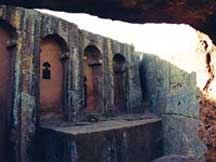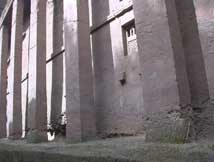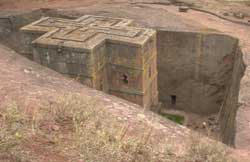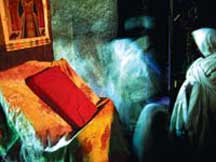The chapel carved in stone
Constructed from the 16th century, until now, 11 churches are still attractive and cause a lot of excitement and curiosity for countless people. The architecture is unique, so strange that even the creator, it is doubtful, whether people believe what they do or not.


Inside the church, the monoliths used to build are still intact.Scientists still do not have an answer about how humans in the 13th century can somehow get these rocks from the surrounding mountains to the construction site.


Unique and holy - the words that tourists often leave after visiting this ancient cross.With a completely stone architecture, built nearly 5m below the ground, this is now the holy land of the Lalibela people.
Lalibela Catholics go to a church in a stone church
Country of stone cathedral
Lalibela is one of the cities of the Amhara clan, also known as Kilil, of Ethiopia. Located at an altitude of 2,500m above sea level in 12.04 North and 39.04 East, the population is about 8,484 people. Lalibela is the center of pilgrimage.
The city has cathedrals built from monolith during the reign of Saint Lalibela (a member of the Zagwe royal family), who ruled over Ethiopia's entire territory during the 13th century. There are 11 ancient churches and divided into 3 groups. The northernmost group: Bete Medhane Alem cathedral, the largest in the world today, is probably a replica from the Church of St. Ary in Aksum, another region in Ethiopia. The westernmost group: Bete Giyorgis church is preserved most intact and the easternmost group consists of 4 churches dedicated to the royal family, in which Bete Gabriel-Rufael cathedral is the place to produce holy bread (from flour) The oldest in the world.
The first Europeans to discover these churches is the Portuguese explorer Civilian (1460 - 1562). However, one of the people who discovered the town of Lalibela was Portuguese priest Francisco Alvares (1465-1540), who accompanied the Portuguese ambassador on a visit to Lebna Dengel in the 1520s.
Masterpiece of anonymous architect

A missionary at the church
The cathedral is completely built in the lava of the mountain. First, around the large lava in the mountainside, people dug very deep, separating it from the mountain. Then, from top to bottom, people dug every meter of stone in the lava, forming a lava cathedral with round roofs, windows, corridors, large room doors . Inside, outside the stone pillar supporting the roof and porch, all of them were hollowed out.
The churches are built firmly and widely. The Redemptorist Church, 33.5m long, 23.5m wide, 10.6m high. Sainte Maria cathedral with windows of Latin and ancient Greek cross, swastika and cross-rolled cross. The stone pillar in the middle of the cathedral covered with cloth.
Churches are connected by lava-like labyrinths. The large mass of lava blocks built Saint Georges cathedral, which is engraved with a cross. Saint Georges is located in a very deep lava tunnel, the underground road connected to the entrance, becoming a monument to the heroic career and extraordinary strength of the church builders.
Architectural researchers of Ethiopian churches have two origins: first, they were built in the Axumite style with the construction of monolithic and wood as the middle pillar; secondly, according to the church architecture deepened with the two rows of columns often found in Roman times. These churches reflect the outstanding architectural tradition of the ancient Axumite and Mediterranean Mediterranean: they bring a new creation of religious art in Ethiopia.
In 1978, Lalibela was recognized as a world cultural heritage by the United Nations Educational, Cultural and Cultural Organization (UNESCO).
Tran Ngoc Phuc
- Found 5,000-year-old legal documents carved on stone
- Detecting ancient rocky beaches dating from 300-400 years in Mu Cang Chai
- Discovering a sundial over 3,000 years old
- Discovered the
- Mysterious temple in India is carved from a single stone block
- Discovered a slate carved with mysterious letters in Jamestown
- 4000 year selfie on the rock
- Discovered a 2,500-year-old gay painting on stone
- Mysterious carved black stones in Peru
- Scientists found a Buddha image carved in stone in Siberia
- Discovered the 4,000-year-old stone slabs carving Atum
- Partial discovery of crucifix crucifixion Jesus?
 Norway built the world's tallest wooden tower
Norway built the world's tallest wooden tower Kremlin
Kremlin Ashurbanipal: The oldest royal library in the world
Ashurbanipal: The oldest royal library in the world Decoding the thousand-year construction of Qin Shihuang shocked the world
Decoding the thousand-year construction of Qin Shihuang shocked the world